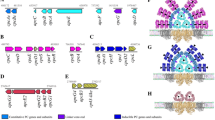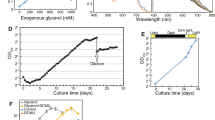Abstract
A cyanobacterium containing phycobiliproteins with far-red acclimation was isolated from Pozas Rojas, Cuatro Ciénegas, México. It was named Leptolyngbya CCM 4 after phylogenetic analysis and a description of its morphological characteristics. Leptolyngbya was grown in far-red light. Sucrose-gradient analysis of the pigments revealed two different colored bands of phycobiliproteins. A band at 60% sucrose was a phycocyanin containing phycobilisome; at 35% sucrose, a new type of phycobiliprotein absorbed at 710 nm. SDS-PAGE revealed the presence of two types of core-membrane linkers. Analysis of the hydrophobic pigments extracted from the thylakoid membranes revealed Chl a, d, and f. The ratio of Chl f/a was reversibly changed from 1:12–16 under far-red light to an undetectable concentration of Chl f under white light. Cuatro Ciénegas, a place surrounded by the desert, is a new ecosystem where a cyanobacterium, which grows in farred light, was discovered.
Similar content being viewed by others
Abbreviations
- AP:
-
allophycocyanin
- Car:
-
carboxisomes
- CCA:
-
complementary chromatic acclimation
- CNE:
-
clear native electrophoresis
- FaRLiP:
-
far-red light photoacclimation
- FNR:
-
ferredoxin-NADP+ reductase
- Fr.:
-
fractions
- LCM :
-
core membrane linker
- PBP:
-
phycobiliprotein
- PBS:
-
phycobilisome
- PC:
-
phycocyanin
- PMSF:
-
phenylmethylsulfonyl fluoride
- REP:
-
repetitive sequence
- RL:
-
red light
- Th:
-
thylakoid membranes
- WCE:
-
whole cell extract
- WL:
-
white light
References
Adir N.: Elucidation of the molecular structures of components of the phycobilisome: Reconstructing a giant.–Photosynth. Res. 85: 15–32, 2005.
Airs R.L., Temperton B., Sambles C. et al.: Chl f and Chl d are produced in the cyanobacterium Chlorogloeopsis fritschii when cultured under natural light and near-infrared radiation.–FEBS Lett. 588: 3770–3777, 2014.
Akutsu S., Fujinuma D., Furukawa H. et al.: Pigment analysis of a Chl f-containing cyanobacterium strain KC1 isolated from Lake Biwa.–Photomed. Photobiol. 33: 35–40, 2011.
Alcántara-Sánchez F., Leyva-Castillo L.E., Chagolla-López A. et al.: Distribution of isoforms of ferredoxin-NADP+ reductase (FNR) in cyanobacteria in two growth conditions.–Int. J. Biochem. Cell B. 85: 123–134, 2017.
Alcaraz L.D., Olmedo G., Bonilla G.: The genome of Bacillus cohauilensis reveals adaptations essential for survival in the relic of an ancient marine environment.–P. Natl. Acad. Sci. USA 105: 5803–5808, 2008.
Anderson L., Eiserling F.A.: Asymmetrical core structure in phycobilisomes of the cyanobacterium Synechocystis sp. PCC 6701.–J. Mol. Biol. 191: 441–451, 1986.
Behrendt L., Brejnrod A., Schliep M. et al.: Chl f-driven photosynthesis in a cavernous cyanobacterium.–ISME J. 9: 2108–2111, 2015.
Bryant D.A., Guglielmi G., de Marsac N.T. et al.: The structure of the cyanobacterial phycobilisomes: a model.–Arch. Microbiol. 123: 113–127, 1979.
Cárabez-Trejo A., Sandoval F.: A mitochondrial inner membrane preparation that sediments at 100 g.–J. Cell Biol. 62: 877–881, 1974.
Castenholtz R.W., Rippka R., Herdman M., Wilmotte A.: Formgenus V. Leptolyngbya Anagnostidis and Komarek 1988.–In: Boone D.R., Castenholtz R.W. (ed.): Bergey’s Manual of Systematic Bacteriology, Vol. 1. Pp. 544–546. Springer-Verlag, New York 2001.
Chang L., Liu X., Li Y. et al.: Structural organization of an intact phycobilisome and its association with photosystem II.–Cell Res. 25: 726–737, 2015.
Chen M., Schliep M., Willows R.D. et al: A red-shifted chlorophyl.–Science 329: 1318–1319, 2010.
Chen M., Blankenship R.E.: Expanding the solar spectrum used by photosynthesis.–Trends Plant Sci 16: 427–431, 2011.
Chen M., Li Y., Birch D., Willows R.D.: A cyanobacterium that contains Chl far red absorbing photopigment.–FEBS Lett. 586: 3249–3254, 2012.
Chen M., Floetenmeyer M., Bibby T.S.: Supramolecular organization of phycobiliproteins in the chlorophyll d-containing cyanobacterium Acariochloris marina.–FEBS Lett. 583: 2535–2539, 2009.
Chisholm S.W., Olson R.J., Zettler E.R. et al: A novel free living prochlorophyte abundant in the oceanic euphotic zone.–Nature 334: 340–343, 1988.
Couradeau E., Benzerara K., Moreira D. et al.: Prokaryotic and Eucaryotic communite structure in field and cultured microbialites from alkaline Lake Alchichica (Mexico).–PLoS ONE 6: e28767, 2011.
Curtis S.E., Haselkorn R.: Isolation and sequence of the gene for large subunit of ribulose-1,5-bisphosphate carboxylase from the cyanobacterium Anabaena 7120.–P. Natl. Acad. Sci. USA 80: 1835–1839, 1983.
Dong C., Tang A., Zhao J. et al.: ApcD is necessary for efficient energy transfer from phycobilisomes to photosystem I and helps to prevent photoinhibition in the cyanobacterium Synechococcus sp. PCC 7002.–Biochim. Biophys. Acta. 1787: 1122–1128, 2009.
Gan F., Bryant D.A.: Adaptive and acclimative responses of cyanobacteria to far-red light.–Environ. Microbiol. 17: 3450–3465, 2015.
Gan F., Shen G., Bryant D.A.: Occurrence of far-red light photoacclimation (FaRLiP) in diverse cyanobacteria.–Life 5: 4–24, 2014b.
Gan F., Zhang S., Rockwell N.C. et al.: Extensive remodeling of a cyanobacterial photosynthetic apparatus in far-red light.–Science 345: 1312–1317, 2014a.
Glazer A.N.: Phycobilisome a macromolecular complex optimized for light energy transfer.–BBA-Bioenergetics 768: 29–51, 1984.
Glazer A.N.: Light guides.–J. Biol. Chem. 264: 1–4, 1989.
Gómez-Lojero C., Pérez-Gómez B., Krogmann D.W. et al.: The tricylindrical core of the phycobilisome Arthrospira (Spirulina) maxima.–Int. J. Biochem. Cell. B. 29: 959–970, 19
Gómez-Lojero C., Pérez-Gómez B., Shen G. et al.: Interaction of ferredoxin:NADP+ oxidoreductase with phycobilisomes and phycobilisome substructures of the cyanobacterium Synechococcus sp. Strain PCC 7002.–Biochemistry 42: 13800–13811, 2003.
Grossman A.R.: A molecular understanding of complementary chromatic adaptation.–Photosynth. Res. 76: 207–215, 2003.
Guglielmi G., Cohen-Bazire G., Bryant D.A.: The structure of Gloeobacter violaceus and its phycobilisome.–Arch. Microbiol. 129: 181–189, 1981.
Ho M.Y., Gan F., Shen G., Bryant D.A.: Far-red light photoacclimation (FaRLiP) in Synechococcus sp. PCC 7335. II. Characterization of phycobiliproteins produced during acclimation to far-red light.–Photosynth. Res. 131: 187–202, 2017.
Ho M.Y., Shen G., Canniffe D.P. et al.: Light-dependent Chl f synthase is a highly divergent paralog of PsbA of photosystem II.–Science 353: 886, 2016.
Houmard J., Capuano V., Colombano M.V. et al.: Molecular characterization of the terminal energy acceptor of cyanobacterial phycobilisomes.–P. Natl. Acad. Sci. USA 87: 2152–2156, 1990.
Hu Q., Marquardt J., Iwasaki I. et al.: Molecular structure, localization and function of biliproteins in the chlorophyll a/d containing oxygenic photosynthetic procaryote Acaryochloris marina.–Biochim Biophys Acta 1412: 250–261, 19
Itoh S., Ohno T., Noji T. et al.: Harvesting far-red light by chl f in photosystems I and II of unicellular cyanobacterium strain KC1.–Plant Cell Physiol. 56: 2024–2034, 2015.
Jordan P., Fromme P., Witt H.T. et al.: Three-dimensional structure of cyanobacterial photosystem I at 2.5 A resolution.–Nature 411: 909–917, 2001.
Kehoe D.M., Gutu A.: Responding to color: the regulation of complementary chromatic adaptation.–Annu. Rev. Plant Biol. 57: 127–150, 2006.
Li Y., Scales N., Blakenship R.E. et al.: Extinction coefficient for red-shifted Chls: Chl d and Chl f.–BBA-Bioenergetics 1817: 1292–1298, 2012.
Li Y., Lin Y., Loughlin P.C., Chen M.: Optimization and effects of different culture conditions on growth of Halomicronema hongdechloris a filamentous cyanobacterium containing Chl f.–Front. Plant Sci. 5: 67, 2014.
Li Y., Lin Y., Garvey C.J. et al.: Characterization of red-shifted phycobilisomes isolated from the Chl f–containing cyanobacterium Halomicronema hongdechloris.–Biochim. Biophys. Acta 1857: 107–114, 20
Liu H., Zhang H., Niedzwiedzki D.M. et al.: Phycobilisomes supply excitations to both photosystems in a megacomplexes in cyanobacteria.–Science 342: 1104–1107, 2013.
Loughlin P., Lin Y., Chen M.: Chlorophyl d and Acaryochloris marina: current status.–Photosynth. Res. 116: 277–293, 2013.
Lundell D.J., Yamanaka G., Glazer A.N.: A terminal energy acceptor of the phycobilisome: the 75,000-dalton polypeptide of Synechococcus 6301 phycobilisome a new biliprotein.–J. Cell Biol. 91: 315–319, 1981.
Mendoza-Hernández G., Pérez-Gómez B., Krogmann D.W. et al.: Interaction of linker proteins with the phycobiliproteins in the phycobilisome substructures of Gloeobacter violaceus.–Photosynth. Res. 106: 247–261, 20
Mielke S., Kiang N., Blankenship R. et al.: Efficiency of photosynthesis in a Chl d-utilizing oxygenic species.–Biochim. Biophys. Acta 1807: 1231–1236, 2011.
Mielke S.P. Kiang N.Y., Blankenship R.E., Mauzerall D.: Photosystem trap energies and spectrally-dependent energy storage efficiencies in the chl d-utilizing cyanobacterium, Acaryochloris marina.–BBA-Bioenergetics 1827: 255–265, 20
Mimuro M., Lipschultz C.A., Gantt E.: Energy flow in the phycobilisome core of Nostoc sp. (MAC): two independent terminal pigment.–BBA-Bioenergetics 852: 307–319, 1986.
Moore L.R., Goericke R., Chisholm S.W.: Comparative physiology of Synechococcus and Prochlorococcus: influence of light and temperature on growth, pigments, fluorescence and absorptive properties.–Mar. Ecol. Prog. Ser. 116: 250–275, 1995.
Pérez-Gómez B., Mendoza-Hernández G., Cabellos-Avelar T. et al: A proteomic approach to the analysis of the components of the phycobilisomes from two cyanobacteria with complementary chromatic adaptation: Fremyella diplosiphon UTEX B590 and Tolypothrix PCC 7601.–Photosynth. Res. 114: 43–58, 2012.
Perkerson III R.B., Johansen J.R., Kovácik L. et al: A unique Pseudanabaenalean (cyanobacteria) genus Nodosilinean gen. nov. based on morphological and molecular data.–J. Phycol. 47: 1397–1412, 2011.
Reuter W., Wehrmeyer W.: Core structure in Mastigocladus laminosus phycobilisomes: II the central part of the tricylindrical core–APCM–contain the anchor polypeptide and no allophycocyanin B.–Arch. Microbiol. 153: 111–117, 1990.
Schägger H., von Jagow G.: Tricine-sodium dodecyl sulfatepolyacrylamide gel electrophoresis for the separation of proteins in the range from 1 to 100 kDa.–Anal. Biochem. 166: 368–379, 1987.
Sidler W.A. Phycobilisome a phycobiliprotein Structures.–In: Bryant D.A. (ed.): The Molecular Biology of Cyanobacteria. Pp. 139–216. Kluwer Academic Publishers, Dordrecht 1994.
Schluchter W.M., Bryant D.A.: Molecular characterization of ferredoxin NADP+ oxidoreductase in cyanobacteria: cloning and sequence of the petH gene of Synechococcus sp. PCC 7002 and studies in the gene product.–Biochemistry 31: 3092–3102, 1992.
Souza V., Eguiarte L.E., Siefert J., Elser J.: Microbial endemism: does phosphorus limitation enhance speciation?–Nat. Rev. Microbiol. 6: 559–564, 2008.
Souza V., Siefert J.L., Escalante A.E. et al.: The Cuatrociénegas Basin in Coahuila, México: An astrobiologial precambrian park.–Astrobiology 12: 641–647, 2012.
Stackebrandt E., Goebel B.M.: Taxonomic note: a place for DNA-DNA reassociation and 16S rRNA sequence analysis in the present species definition in bacteriology.–Int. J. Syst. Bacteriol. 44: 846–849, 1994.
Stanier G. (Cohen-Bazire): Fine structure of cyanobacteria.–Methods Enzymol. 167: 157–172, 1988.
Stevens Jr S.E., Pat Patterson C.O., Myers J.: The production of hydrogen peroxide by blue-green algae: A survey.–J. Phycol. 9: 427–430, 1973.
Tandeau de Marsac N., Houmard J.: Complementary chromatic adaptation: Physiological conditions and action spectra.–Methods Enzymol. 167: 318–328, 1988.
Taton A., Grubisic S., Brambilla E. et al.: Cyanobacterial diversity in natural and artificial microbial mat of Lake Fryxell (Mc Murdo Dry Valleys Antarctica): A morphological and molecular approach.–Appl. Environ. Microbiol. 69: 5157–5169, 2003.
Umena Y., Kawakami K., Shen J.R., Kamiya N.: Crystal structure of oxygen evolving photosystem II at a resolution of 1.2 A.–Nature 473: 55–60, 2011.
Wittig I., Karas M., Schägger H.: High resolution clear native electrophoresis for In-gel functional assays and fluorescence studies of membrane protein complexes.–Mol. Cell. Proteomics 6: 1215–1225, 2007.
Yamanaka G., Glazer A.N., Williams R.C.: Cyanobacterial phycobilisomes. Characterization of the phycobilisomes of Synechococcus sp. 6301.–J. Biol. Chem. 253: 8303–8310, 1978.
Zhang Z., Schwartz S., Wagner L., Miller W.: A greedy algorithm for aligning DNA sequences.–J. Comput. Biol. 7: 203–214, 2000.
Zuker M.: Mfold web server for nucleic acid folding and hybridization prediction.–Nucleic Acids Res. 31: 3406–3415, 2003.
Author information
Authors and Affiliations
Corresponding author
Additional information
Acknowledgments: This paper is dedicated to the memory of Dr. David W Krogmann: professor, colleague, and friend. CGL thanks Dr. Valeria Souza for the opportunity to be at Cuatro Ciénegas in May, 2012, where the mat sample was obtained. The authors wish to thank to Mr. Jorge Zarco Mendoza for his technical expertise, Dr. Laura Ongay and Biologist Ma. Guadalupe Codiz of the Unidad de Biología Molecular, Instituto de Fisiología Celular UNAM for DNA sequencing, and Mrs. Leticia Gómez-Sandoval for her secretarial assistance.
Rights and permissions
About this article
Cite this article
Gómez-Lojero, C., Leyva-Castillo, L.E., Herrera-Salgado, P. et al. Leptolyngbya CCM 4, a cyanobacterium with far-red photoacclimation from Cuatro Ciénegas Basin, México. Photosynthetica 56, 342–353 (2018). https://doi.org/10.1007/s11099-018-0774-z
Received:
Accepted:
Published:
Issue Date:
DOI: https://doi.org/10.1007/s11099-018-0774-z




